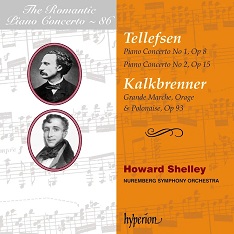Der aus Trondheim gebürtige Thomas Tellefsen (1823-1874) verließ Norwegen 1842, um in Paris Musik zu studieren. Dort kam er in Kontakt mit Chopin und wurde dessen Schüler und Freund. Nach Chopins Tod im Jahr 1849 unterrichtete er einige seiner Schüler und erwarb sich großes Ansehen als Lehrer. In den 1850er und 60er Jahren war er als einer der größten Klaviervirtuosen in Frankreich, Großbritannien und Skandinavien bekannt. Er hinterließ vierundvierzig Kompositionen, die eine gewisse Nähe zu Chopin aufweisen.
Die beiden Konzerte sind sicherlich nicht unangenehm zu hören, aber bis auf den letzten Satz des ersten Konzerts und den letzten des zweiten fehlt es Tellefsens Musik an Charakter. Howard Shelley und die Nürnberger Symphoniker geben sich redlich Mühe, die Musik gut zu spielen, aber wo nichts viel ist, kann auch nicht viel werden.
Kalkbrenners im Original für Klavierquintett komponierte Grande Marche, Orage et Polonaise ist recht phantasievoll komponiert, aber von den vielen Motiven will sich einem keines so richtig einprägen.
So bleibt dieses höchstens dokumentarisch interessante Album eines für erklärte Alles-Sammler im Bereich romantischer Musik.
Born in Trondheim, Thomas Tellefsen (1823-1874) left Norway in 1842 to study music in Paris. There he came into contact with Chopin and became his pupil and friend. After Chopin’s death in 1849, he taught some of his pupils and gained a great reputation as a teacher. In the 1850s and 60s, he was known as one of the greatest piano virtuosos in France, Great Britain and Scandinavia. He left behind forty-four compositions that show a certain closeness to Chopin.
The two concertos are certainly not unpleasant to listen to, but apart from the last movement of the first concerto and the last of the second, Tellefsen’s music lacks character. Howard Shelley and the Nuremberg Symphony Orchestra make a real effort to play the music well, but where nothing is much, not much can be.
Kalkbrenner’s Grande Marche, Orage et Polonaise, originally composed for piano quintet, is quite imaginatively composed, but of the many motifs, none of them really wants to be memorized.
As a result, this album, which is of documentary interest at best, remains one for avowed collectors of everything in the field of romantic music.




















